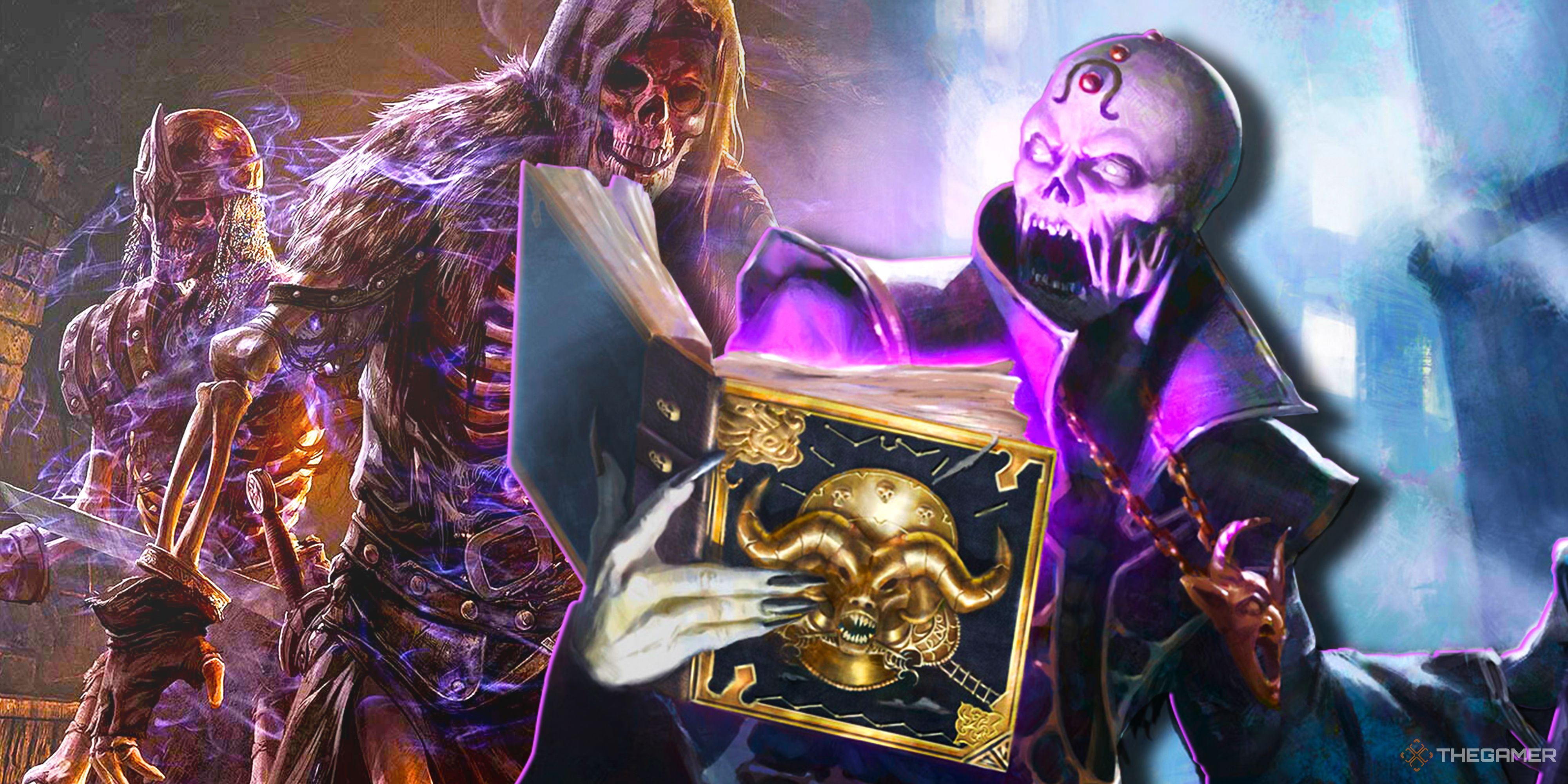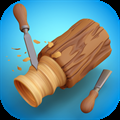
Dungeons & Dragons gives you a significant degree of freedom when creating your characters, supporting various gameplay styles and character archetypes through class, subclass, and race options. Regarding spellcasters, one option associated with traditionally villainous characters is necromancers, those who wield magic that can raise the dead.
RelatedDungeons & Dragons: How To Build A Warrior Of The Elements Monk
Learn how to build a Warrior Of The Elements Monk in D&D!
PostsWhile Necromancy is traditionally viewed as wicked, D&D allows you to build fleshed-out necromancers that specialize in commanding the undead. So whether you're a DM looking to create a heinous necromancer antagonist or a player looking to create an adventurer who makes the most out of undead in combat, here's everything you need to know about playing a necromancer in D&D.
Updated October 26, 2024, by Sean Murray: Dungeons & Dragons continues to evolve with D&D 2024, the latest rules refresh that changes many aspects of how to play the venerable tabletop game. We've refreshed this guide to reflect the new player origin rules so you can make your Necromancer in Dungeons & Dragons 2024.
How To Raise The Undead
Dr. Viktra Mordenheim crafts a body for her undead experimentation via Wizards of the CoastWhen building a necromancer in D&D, the meat and potatoes of your strategy is the ability to raise the dead as zombies and skeletons to do your bidding. When creating undead servants in D&D's fifth edition, the most direct means of doing this is through the Animate Dead spell.
Animate Dead is a third-level spell of the School of Necromancy and is the backbone of any necromancer's arsenal.
With a casting time of one minute, Animate Dead targets the corpse or bones of one medium or small-sized humanoid, raising it as a zombie or skeleton, respectively. As a bonus action, the spell's caster can telepathically issue any undead raised with the spell to carry out specific orders.
When utilizing Animate Dead, there are various important factors that it's important to be aware of. Firstly, this spell lasts for twenty-four hours, meaning that you can have an undead creature at your disposal for a significant amount of time.
Secondly, if you cast this spell to target a zombie or skeleton you already control before the spell ends, you reassert control over it and extend its duration for an additional twenty-four hours. This means that as long as you remember to reassert control over your undead minions, you can keep your favorite undead servants around indefinitely.
Growing Your Undead Horde
Clattering Skeletons art by Aleksi BriclotAmong the most integral elements of Animate Dead to be aware of is the fact that this spell doesn't require concentration. This means that it can be reliably cast several times per day while remaining active, allowing you to control several undead minions at once.
Moreover, when casting Animate Dead using a spell slot above third level, you can animate the remains of not one but two additional creatures.
This means that through the use of several higher-level spell slots, a single necromancer can control a sizable swarm of undead with ease.
RelatedDungeons & Dragons: Every Ranged Weapon, Ranked
From a dart to the many types of crossbows, here are the best ranged weapons in D&D, ranked!
PostsWhich Classes Can Be Necromancers
Danse Macabre art by Randy VargasDue to the importance of the Animate Dead spell when building a necromancer, those looking to play such characters are confined to classes and subclasses capable of learning this spell. The following classes and subclasses are capable of learning the Animate Dead spell:
Class
Subclass
Book
Wizard
All subclasses (Automatically gained by School of Necromancy at sixth level)
Player's Handbook
Cleric
All subclasses (Automatically gained by Death Domain at fifth level)
Player's Handbook
Druid
Circle of Spores at fifth level
Tasha's Cauldron of Everything
Paladin
Oathbreaker at ninth level
Dungeon Master's Guide
The class (and subclass) capable of making the most out of this spell is the School of Necromancy wizard. While the ability to learn the spell is a nice feature for clerics, druids, and paladins, School of Necromancy wizards significantly improve the benefits of controlling undead.
As of sixth level, whenever a School of Necromancy wizard casts Animate Dead, they can target an additional corpse, increasing the number of zombies they can command at once. In addition to improving the number of your zombies or skeletons, this subclass also improves their quality.
All undead raised by School of Necromancy wizards gain additional max HP equal to the wizard's level and add that wizard's proficiency bonus to each of their weapon damage rolls, simultaneously bolstering their offense and survivability.
Making The Most Out Of Your Undead
Rudolph Van Richten and an Undead Spirit via Wizards of the CoastAs creatures with the ability to take actions in and out of combat, undead minions summoned through Animate Dead can offer a substantial degree of value, especially when summoned in large numbers. One of the most notable features of the Animate Dead spell is the fact that it allows you to use your bonus action to telepathically command any number of undead that you control.
This means that if several undead are under your command, you can effectively make several attacks and lock down a target as a bonus action.
Through the command over several creatures, you can also interact with your surroundings, move items to your allies, restrain foes through grappling, or even offer several Help actions to your comrades.
Furthermore, undead under your control will even carry out indefinite commands, such as to protect a given location, making the spell and the potential application of the undead incredibly flexible.
RelatedDungeons & Dragons: What Is Constitution Used For?
Constitution is one of the most important abilities in Dungeons & Dragons.
PostsNecromancy Out Of Combat
Sinister Forces by Paul Scott CanavanOne element of necromancers that may make or break the archetype for some players is the act of roleplaying this type of magic user. Due to the taboo that comes along with animating the dead to serve as one's tools, many NPCs may not be particularly kind to your undead legion.
While necromancers can be incredibly powerful from a mechanical standpoint, in the context of a roleplaying game like D&D, few types of magic are as morally questionable as necromancy.
Playing a necromancer opens up several cans of worms regarding how the character may travel and how they obtain new undead to control. Does your necromancer publicly travel with their horde of the undead, and are you prepared to face the consequences of doing so? Do you hide your zombies, and if so, how? Do you only animate the bodies of those you defeat in your adventures? Are any types of bodies off-limits for reanimation?
Examining and answering these types of questions not only helps flesh out your character from a practical point of view, but it also helps you to establish your necromancer and their rationale, especially if they aren't evil.
The Best Spells For A Necromancer
Archlich Acererak by Tyler JacobsonWhen it comes to playing an archetypal necromancer leading a horde of the undead, Animate Dead is easily the most integral spell to learn, even being gained automatically by Necromancy School Wizards automatically. However, one spell doesn't make up an archetype on its own.
As wizards of the School of Necromancy can learn additional Necromancy spells for halved time and gold, it's worth considering learning the best spells available in the school. Below are great spell options perfect for your next necromancer.
Spell Name
Level
Effect
Toll The Dead
Spell Level: Cantrip
Among the most highly damaging cantrips in the game, when targeting a creature that is missing at least one hit point, this Cantrip deals 1d12 Necrotic damage to its target. As this damage increases as you gain levels, this Necromancy School cantrip can deal serious damage without requiring you to spend spell slots.
Mold Earth
Spell Level: Cantrip
Though not a cantrip of the School of Necromancy, Mold Earth allows you to manipulate earth or stone that fits within a five-foot cube. This means that this cantrip can be used to help move the ground that's standing between you and potential new additions to your undead horde while subverting the need to pick up a shovel.
Ray Of Enfeeblement
Spell Level: 2nd
Though it doesn't interact with your ability to command the dead, Ray of Enfeeblement is a solid second-level spell that can be used to prevent large sums of damage when fighting physically-oriented foes that will primarily be aiming to deal bludgeoning, piercing, or slashing damage. While Wizards may not have access to healing magic, Ray of Enfeeblement can at least postpone when a party needs healing in the first place.
Summon Undead
Spell Level: 3rd
An alternative to Animate Dead, Summon Undead calls forth an undead spirit that can have different stats and abilities depending on whether they're Putrid, Ghostly, or Skeletal in nature. The downside is that this spell requires concentration, but it's still a potent addition to your regular reanimated army.
Danse Macabre
Spell Level: 5th
Though less permanent than Animate Dead, Danse Macabre allows you to raise up to five corpses as your undead minions for up to an hour. In addition to providing access to up to five undead creatures for an hour, the quality of these undead is slightly higher than those created through Raise Dead, as these zombies add your spellcasting modifier to their attack and damage rolls.
Negative Energy Flood
Spell Level: 5th
A single-target damaging spell that deals 5d12 necrotic damage, if you kill a creature with this spell, it immediately raises as a zombie and starts to attack the creature closest to it. Uniquely, if you target an undead with this spell, it instead gains 5d12 hit points rather than sustaining damage. As the majority of healing magic doesn't work on the undead, this is one of the few means of healing your favorite undead minions.
Create Undead
Spell Level: 6th
Create Undead is a nearly identical spell to Animate Dead, though with one major upgrade. While Animate Dead raises the dead as zombies or skeletons, Create Undead allows you to raise Ghouls, a more resilient and dangerous form of undead creature. Once this spell is learned, it will become a staple of your repertoire.
Finger Of Death
Spell Level: 7th
Dealing a sizable 7d8 + 30 necrotic damage to a single target, if the target of this spell dies, they immediately raise as a zombie permanently under your control. Unlike Animate Dead and Create Undead, an undead minion gained through this spell doesn't require you to regularly reassert your control over it.
Clone
Spell Level: 8th
Exclusive to Wizards and incredibly useful, Clone effectively allows you to make backup bodies for yourself that your soul can transfer into when you die. This Necromancy spell single-handedly opens the door for your character to become practically immortal.
read moreIn addition to these spells, it's worth picking up other Wizard classics, such as Fireball and Counterspell in order to support your companions as your party's premier arcane caster.
RelatedDungeons & Dragons: Weapon Masteries That Work Well Together
Double up these weapon masteries for maximum impact in Dungeons & Dragons.
PostsHow To Build Your Necromancer
A reborn emerges from an apparatus via Wizards of the CoastLuckily, when building a necromancer, things are somewhat cut and dry. Outside a few decisions, there is a lot of room for choice in things like your character's feats and races that can make your necromancer feel like your own.
Ability Scores
First and foremost, as a Wizard, the most integral ability score for your character is your Intelligence, as it is used for a significant number of your spells. Additionally, prioritizing your Constitution is never a bad idea (especially as a Wizard with a d6 hit die) as it provides you with much-needed HP.
Furthermore, as a Wizard, if you care about raising your armor class, the quickest way to do so is simply by increasing your Dexterity. As for your remaining three ability scores, it's entirely up to you which you feel are the most important to the character you're creating.
Here's the recommended starting ability score.
Strength
Dexterity
Constitution
Intelligence
Wisdom
Charisma
Standard Array
8
13
14
15
12
10
Points Buy
8
14
14
15
12
8
Background
The Book of Vile Darkness art by Daniel LjunggrenBy far, the best background to pick for your Necromancer's origin is the sage. You get to increase both your Intelligence and Constitution, you gain proficiency in both Arcana and History (two Intelligence-based skills), and you get the Magic Initiate origin feat.
As a spellcaster, the more spells you have access to, the better. Magic Initiate provides two cantrips and a level one spell that can be cast once per short rest.
A good spell to choose with Magic Initiate is Mage Armor, which lasts eight hours.
Scribe, Merchant, and Criminal are also decent backgrounds for a Necromancer as they all provide the option of boosting Intelligence, but none come with the Magic Initiate origin feat.
Species
Any species can raise the dead, but some are just a little better at it than others. Here's a breakdown on each species with how well-suited they are to being a Necromancer.
Species
Reason
Human
Having two origin feats means being to take both Magic Initiate from sage and either the Lucky or Tough feats, both of which can be a huge boost to your character.
Elf
High elf gains access to another wizard cantrip, Detect Magic, and Misty Step, all of which are great spells to have in your spellbook.
Dwarf
Dwarven Resilience and Toughness can really help bulk up a traditionally frail class.
Gnome
Advantage on all the non-physical saving throws is a huge bonus to any mage character.
Tiefling
Infernal tiefling can get several great spells, including Firebolt, Darkness, and Hellish Rebuke. Plus, the horns really sell the whole demonic necromancer look.
Goliath
Cloud giant and stone giant are two goliath ancestries that are great for spellcaster characters, although being so large will make it hard to hide in a crowd.
Dragonborn
Resistance to an elemental damage is nice, and so is being able to fly, but the breath weapon isn't a huge deal.
Halfling
The sneakiest species doesn't have a lot to offer a Necromancer, other than Halfling Luck of course.
Aasimar
You could cosplay as the angel of death, but there isn't much that an Aasimar brings to the Necromancer party.
Orc
Restless Endurance can help with your fragility as a wizard, but most Orcish traits are more helpful to melee-based characters.
Feats
Summon Undead art by Dallas WilliamsYou should generally plan to have your Intelligence score reach 20 as quickly as possible. This usually means taking the Ability Score Increase feat until you're either 19 or 20, and then looking at other feats.
There are several feats that are well-suited to the Necromancer. First among them is Inspiring Leader. This feat gives temporary hit points to your minions just for giving a rousing speech before battle. It also increases your Intelligence, Wisdom, or Charisma by one (choose Intelligence).
War Caster is another great feat. This can also increase your Intelligence score by one and provides advantage on Constitution saves to retain concentration on spells. You also get the Reactive Spell feature, which lets you cast spells as opportunity attacks.
Finally, Resilience can also help with passing those pesky concentration checks by increasing your Constitution score by one and providing proficiency in Constitution saving throws.
For more on how to build a School of Necromancy wizard from level zero to 20, check out our dedicated guide on the subject here.
NextDungeons & Dragons: Every Simple Melee Weapon, Ranked
A complex ranking for a simple weapon classification
Posts












